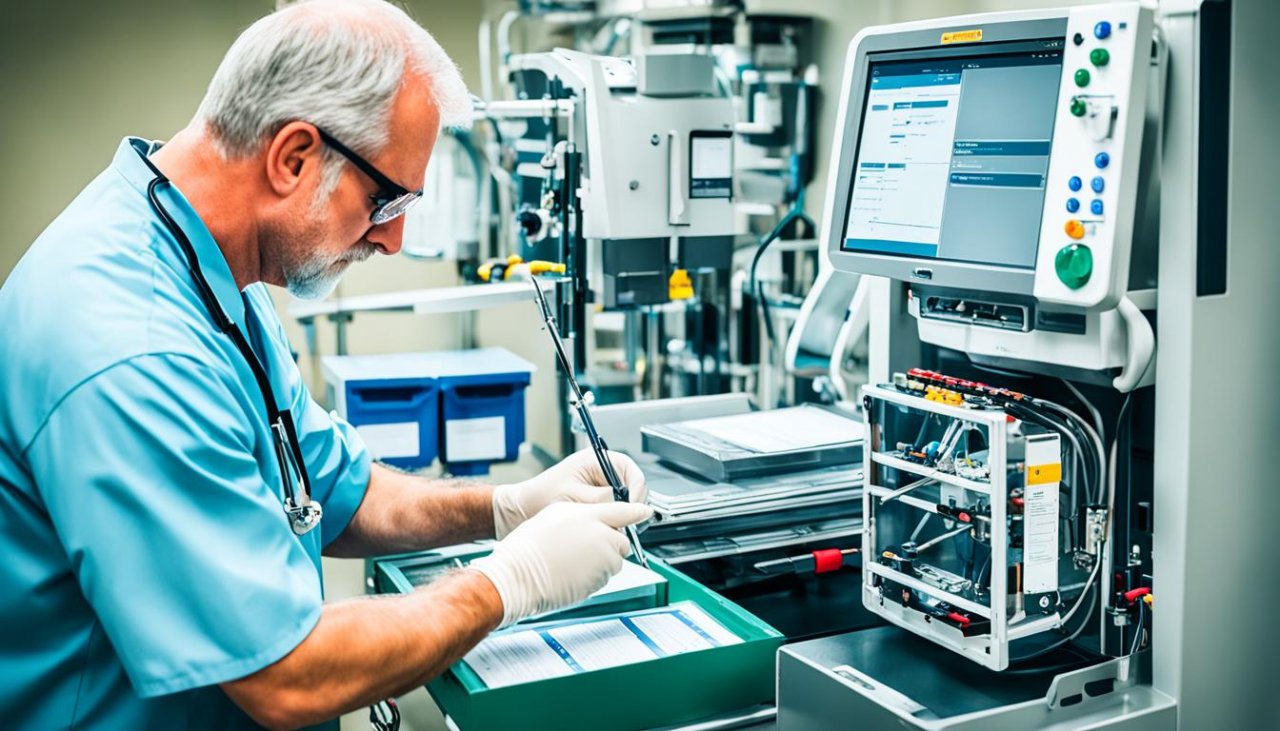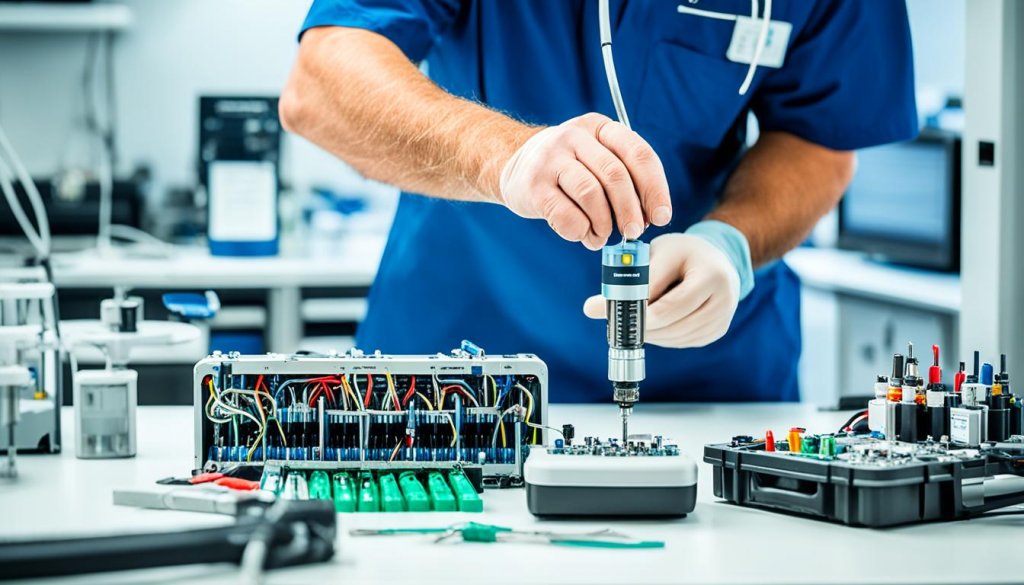Have you ever thought about how a small mistake in medical equipment upkeep could affect patient safety or how well a hospital runs? In healthcare, making sure medical equipment meets standards is key. It keeps patients safe and hospitals efficient.
Since 2017, The Joint Commission has made it clear that all medical equipment must be fully compliant. With over 22,000 healthcare places accredited, the need for strict rules on healthcare tools is bigger than ever. It’s not just a rule; it’s a promise to give top-quality care. This includes everything from regular upkeep to keeping detailed maintenance records.
Knowing how to handle the complex rules on equipment safety helps healthcare workers. They can cut down on equipment downtime and follow strict rules. Let’s look at how good medical equipment care is changing healthcare for the better.

Key Takeaways
- The Joint Commission requires 100% compliance with equipment maintenance to enhance patient safety.
- Preventive maintenance is essential for reducing equipment failures and associated costs.
- Accurate maintenance logs are crucial for demonstrating adherence to regulatory requirements.
- Corrective maintenance often leads to higher costs compared to preventive approaches.
- Regular updates and reviews of equipment safety standards help mitigate risks in healthcare settings.
Understanding the Importance of Medical Equipment Compliance
Medical equipment compliance is key in healthcare. It makes sure devices work well and follow important rules. It’s important for many reasons, like keeping equipment running smoothly.
By doing regular maintenance, I can cut down on unexpected downtime. This lets healthcare providers focus on patients without interruptions.
Maximizing Equipment Uptime
Keeping equipment running is crucial for healthcare services. Regular checks mean fewer breakdowns, so care isn’t interrupted. This helps healthcare groups improve their services.
It also makes a better work environment for patients and staff. This strengthens the healthcare system overall.
Ensuring Patient Safety
Keeping patients safe is the top goal in healthcare. Medical equipment that follows rules works right and lowers risks. Each device must pass safety tests to protect patients during their stay.
When devices follow the rules, the chance of harm goes down. This focus on safety is key in healthcare, where patients’ well-being comes first.
Regulatory Requirements
Rules from groups like The Joint Commission require strict following of medical equipment rules. Staying in line with these standards keeps accreditation and ensures safety in healthcare places. I know the rules change often to make equipment safer and more effective.
Keeping up with these changes helps with medical equipment compliance. It shows a strong commitment to quality patient care.
Overview of Healthcare Regulatory Requirements
Understanding healthcare regulatory requirements is key for the safety and effectiveness of medical devices. These rules make sure facilities work well and keep patients and healthcare workers safe. Following these rules means going through different processes and sticking to guidelines from important groups.
Key Regulatory Bodies
Several groups play a big role in healthcare compliance. The Food and Drug Administration (FDA) is key in checking medical devices, putting them into Class I, II, and III groups. The FDA’s Center for Devices and Radiological Health (CDRH) makes sure manufacturers follow important standards. Agencies like the Occupational Safety and Health Administration (OSHA) also help keep healthcare workplaces safe and in line with the rules.
Compliance Guidelines
Facilities must follow strict rules to deal with healthcare regulations. This means keeping good maintenance records, registering with the FDA, and following the Quality System (QS) rule under 21 CFR Part 820. Also, each place must report any issues with devices under the Medical Device Reporting program to keep an eye on safety.

The Role of The Joint Commission in Compliance
The Joint Commission plays a key role in making healthcare safer and better. It checks that places meet high standards through its strict accreditation process. This process includes steps like getting ready, applying, the first survey, making a decision, promoting, and always getting better.
Places get checked without warning every 18 to 36 months. During these checks, they must meet the standards set. This is very important because about 70 to 80% of what The Joint Commission does is about keeping patients safe.
Accreditation Process Overview
Getting accredited by The Joint Commission shows a place’s dedication to following safety rules and caring for patients. It costs about $46,000 a year to keep up with standards and get checked. The Joint Commission uses a special way to check if places follow the rules, looking at many different things closely.
This way, places make sure they are safe and care for patients well. It also helps improve the care they give.
Importance of The Gold Seal of Approval™
The Gold Seal of Approval™ means a healthcare place meets the highest care standards. This makes them more credible and trusted by patients. It also lets them get paid for advanced medical treatments.
Places that get accredited by The Joint Commission gain a lot from this top honor. It makes their reputation in healthcare better.
Different Types of Maintenance: Preventive and Corrective
Keeping medical equipment in good shape is key to following safety rules and working well. Knowing about preventive and corrective maintenance helps me make the most of my equipment and cut costs.
Defining Preventive Maintenance
Preventive maintenance means checking and fixing medical devices regularly to stop problems before they start. This way, I save money and resources by making my equipment last longer. It started in the early 1900s with complex technologies, and now, tools like CMMS and EAM help manage maintenance better.
These systems keep track of maintenance history and work orders. They make sure small issues don’t turn into big problems.
Understanding Corrective Maintenance
Corrective maintenance fixes a device after it breaks, aiming to get it working again. It can be easier but might cost more and cause delays in patient care. Using only this method could mean missing chances for preventive care that keeps devices in line with safety standards.
By using both types of maintenance, I can keep my equipment reliable and help make healthcare more efficient.

Establishing an Effective Equipment Maintenance Log
Creating a detailed equipment maintenance log is key for tracking all maintenance work on medical gear. This log makes sure we follow industry rules and boosts the efficiency of our healthcare facility.
What to Include in Your Maintenance Log
An effective log should have a few main parts. First, it’s important to clearly identify each piece of equipment. Then, I log routine checks, like when to lubricate and inspect them. Keeping up with these details keeps us in line with medical equipment rules and gets us ready for audits.
Using a standard way to log maintenance makes things easier and more accurate.
The Benefits of Maintaining Accurate Records
Keeping accurate records in our maintenance log has many benefits. By looking at past data, I can stop problems before they get worse. This also makes sure we follow the rules and avoids fines.
It helps us keep an eye on how well the equipment works, which makes patients safer and staff more responsible. Having organized logs gives us insights that help us make better decisions in healthcare.
Medical Equipment Compliance Checklist
Creating a medical equipment compliance checklist helps ensure all essential items are covered. It acts as a guide, helping follow regulations and improve healthcare facility operations. This approach reduces issues caused by faulty equipment.
Essential Items for Compliance
When making a checklist, I focus on maintenance schedules, equipment certifications, and safety checks. Important items like vital monitors, X-ray systems, and centrifuges must be listed. It’s key to do Electrical Safety Inspections (ESI) at three main times: when equipment arrives, before it’s used on patients, and yearly.
Recording all service, repair, and quality control events is vital. These records should be kept for three years. Regular checks are a must for devices used in Radiology, Labs, and Autoclaves to ensure they’re safe.
Regular Review and Updates
It’s crucial to regularly review the checklist to keep up with changes in equipment use and rules. This helps me quickly fix any issues and follow industry standards. Working with groups like MECA for testing and documentation ensures equipment meets standards like the IEC 60601 series.
Keeping the checklist current helps maintain compliance and boosts medical equipment performance in the facility.
Meeting Equipment Safety Standards
In the healthcare world, it’s crucial to meet equipment safety standards. This ensures that medical devices work right and are safe for patients. Knowing about equipment certification helps healthcare places deal with complex rules. Following these standards makes things safer and more efficient, helping both healthcare workers and patients.
Understanding Equipment Certification Guidelines
The IEC 60601 family of standards is key in healthcare equipment. These rules cover devices that touch patients, transfer energy, and detect energy transfer. Devices like ventilators and x-ray machines must follow these rules to be safe and work well.
It’s also important to follow guidelines for equipment certification, including risk management as per IEC 14971. This means devices must be safe and meet specific standards. Using parts that aren’t certified might save money but can be risky, putting patients in danger.
With new tech like AI and robotics in medical devices, following standards is harder. It’s important to know about rules like IEC 62304 for medical software early on. This helps with getting certified and keeps devices safe and effective.
The Impact of FDA Regulations on Medical Instruments
Understanding FDA rules for medical tools is key for healthcare groups. The FDA sets strict rules for how medical gear must be documented and kept safe. These rules protect patients and shape how medical device companies sell their products. Following FDA guidelines boosts trust and helps get more equipment into hospitals.
Key FDA Requirements for Equipment Compliance
Getting FDA approval needs a lot of research and knowing about regulations. Companies must plan for the time and money needed for FDA approval. This approval process depends on the device type.
Meeting labeling and safety checks after a device hits the market is crucial. FDA-approved devices are more trusted and often get insurance coverage. This makes following FDA rules a big plus for sales.
Ensuring Compliance with FDA Regulations
Healthcare groups must keep learning about FDA rules. They need to train staff on following these rules. New ideas in these rules can help companies stand out.
Creating a culture that values following rules helps meet safety and quality standards. This leads to better patient care and success for the organization.
See how FieldAx can transform your Field Operations.
Try it today! Book Demo
You are one click away from your customized FieldAx Demo!
FAQ
What is medical equipment compliance?
Medical equipment compliance means following rules for maintenance and safety. These rules come from groups like The Joint Commission and the FDA. It makes sure medical devices work well and safely, keeping patients safe.
Why is preventive maintenance important for medical equipment?
Preventive maintenance is key because it keeps equipment running and lowers the chance of sudden breakdowns. Regular checks and upkeep help avoid expensive delays and keep patients safe.
What are the key regulatory bodies involved in healthcare compliance?
Important groups include the FDA, OSHA, and The Joint Commission. Each has rules that healthcare places must follow.
How does The Joint Commission contribute to healthcare compliance?
The Joint Commission helps keep healthcare in line through its accreditation process. This includes surprise checks and ongoing checks to make sure patients are safe.
What should be included in an effective equipment maintenance log?
A good maintenance log lists the equipment, its maintenance history, and who worked on it. It also includes the current status and calibration details. This log proves compliance and is key for audits.
What are some essential items in a medical equipment compliance checklist?
Must-haves include maintenance plans, equipment approvals, safety checks, and FDA rule follow-up. Regular updates keep the checklist current with new rules or changes in equipment.
Why are equipment safety standards crucial in healthcare?
Safety standards make sure medical devices work right and are safe for patients. Following these standards is key for keeping patients safe and keeping healthcare running smoothly.
What are the FDA’s key requirements for medical equipment compliance?
The FDA needs proof of quality control, correct device labels, and that devices meet safety and effectiveness standards. This helps protect patients and avoids fines.
Author Bio
Co-Founder & CMO at Merfantz Technologies Pvt Ltd | Marketing Manager for FieldAx Field Service Software | Salesforce All-Star Ranger and Community Contributor | Salesforce Content Creation for Knowledge Sharing





